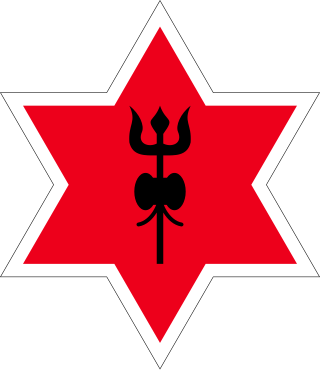Gadhi is a village development committee in the Narayani Zone of southeastern Nepal.
Gadhi may also refer to:

The Nepalese Armed Forces are the military forces of Nepal. Composed primarily of the ground-based Nepali Army, organized into six active combat divisions, the Nepalese Armed Forces also operates the smaller Nepalese Army Air Service designed to support army operations and provide close light combat support. The Nepalese Army also operates smaller formations responsible for the organization of air defense, logistics, military communications, artillery, and airborne forces within Nepalese territory. In addition, the Armed Police Force acts as a paramilitary force tasked with maintaining internal security within Nepal.

The Anglo-Nepalese War, also known as the Gorkha War, was fought between the Gorkhali army of the Kingdom of Nepal and the British forces of the East India Company. Both sides had ambitious expansion plans for the mountainous north of the Indian Subcontinent. The war ended with the signing of the Sugauli Treaty in 1816, which ceded some of the Nepalese-controlled territory to the EIC.

The Terai or Tarai is a lowland region in northern India and southern Nepal that lies south of the outer foothills of the Himalayas, the Sivalik Hills, and north of the Indo-Gangetic Plain. This lowland belt is characterised by tall grasslands, scrub savannah, sal forests and clay rich swamps. In North India, the Terai spreads from the Yamuna River eastward across Haryana, Uttarakhand, Uttar Pradesh, Bihar and West Bengal. The Terai is part of the Terai-Duar savanna and grasslands ecoregion. The corresponding lowland region in West Bengal, Bangladesh, Bhutan and Assam in the Brahmaputra River basin is called 'Dooars'. In Nepal, the term is applied to the part of the country situated north of the Indo-Gangetic Plain. Nepal's Terai stretches over 33,998.8 km2 (13,127.0 sq mi), about 23.1% of Nepal's land area, and lies at an elevation of between 67 and 300 m. The region comprises more than 50 wetlands. North of the Terai rises the Bhabar, a narrow but continuous belt of forest about 8–12 km (5.0–7.5 mi) wide.

Sunsari District is one of 14 districts in Koshi province of Nepal. The district is located in the eastern part of the Outer Terai and covers an area of 1,257 km2 (485 sq mi). According to the 2011 Nepal census, the population was 753,328. The district headquarters is located in Inaruwa.
Wambule is a Kiranti language language spoken by the Wambule Rai, one of the Rai groups belonging to the Kiranti (किरान्ती) ethnolinguistic family of eastern Nepal. Wambule is spoken by more than 5000 people living around the confluence of the Sunkosi (सुनकोसी) and Dudhkosi (दूधकोसी) rivers near Kui-Bhir Hill. The Wambule-speaking area comprises the southernmost part of Okhaldhunga district, the westernmost part of Khotang district, the northernmost part of Udayapur district, and the northeasternmost part of Sindhuli district.

Inaruwa is the headquarter of Sunsari district that lies in the Koshi province of Eastern Nepal. Inaruwa is a municipality since the time of Panchayat in the year 2047 BS. After 2015, it has been operating under a mayor-council form of government and is currently led by Mayor Kedar Bhandari. Spanning 77.92 square kilometers, the Municipality is home to a population of nearly 75 thousand residents.
Basantapur may refer to several places in Nepal:
Inaruwa may refer to:

Barahachhetra is a Hindu and Kirat piligram site which remains between the confluence of Koka and Koshi rivers in Barahakshetra, Sunsari of Koshi Province, Nepal. This place is one of Nepal's oldest shrines mentioned in Puranas including Brahma Purana, Varaha Purana and Skanda Purana and even mentioned and glorified in the Mahabharata epic. In Barahachhetra, the Varah, an incarnation of Vishnu is worshiped. Barahachhetra is one of the Char Dham in Nepal.
Duhabi is a municipality in Sunsari District in the Koshi Zone of south-eastern Nepal. At the time of the 2001 Nepal census it had a population of 17,574. Duhabi is situated in between Itahari and Biratnagar, on the bank of Budi River. It is the center of Sunsari–Morang industrial corridor.
Dumara may refer to:
Harinagar may refer to:
Jhumka may refer to:
Ramdhuni is a municipality located in the Sunsari district, Koshi Province of Eastern Nepal. It was established in 2014. Ramdhuni previously known as Jhumka Bazar. It is approximately 356km far from Kathmandu. This town lies in the middle of two famous cities Itahari and Inaruwa. Mahendra highway passes right through the heart of the town. Chatara Canal originates all the way from Koshi River and flows through the town from north to south. This canal plays an important role in the agriculture of Sunsari and Morang district. Ramdhuni has a total area of 48.10 square kilometers. It has a population of 28,549 of which 13,211 are males and 15,388 are females living in 6,347 individual houses.
Bhokraha or Bhokraha Narsingh is a rural municipality (gaunpalika) out of six rural municipality located in Sunsari District of Province No. 1 of Nepal. There are a total of 12 municipalities in Sunsari in which 6 are urban and 6 are rural.
Gadhi is a rural municipality (gaunpalika) out of six rural municipality located in Sunsari District of Province No. 1 of Nepal. There are a total of 12 municipalities in Sunsari in which 6 are urban and 6 are rural.

Sunsari 2 is one of four parliamentary constituencies of Sunsari District in Nepal. This constituency came into existence on the Constituency Delimitation Commission (CDC) report submitted on 31 August 2017.

Sunsari 3 is one of four parliamentary constituencies of Sunsari District in Nepal. This constituency came into existence on the Constituency Delimitation Commission (CDC) report submitted on 31 August 2017.

Sunsari 4 is one of four parliamentary constituencies of Sunsari District in Nepal. This constituency came into existence on the Constituency Delimitation Commission (CDC) report submitted on 31 August 2017.